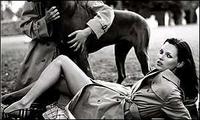 150-year old Burberry is one of the oldest brands around. It became famous for its invention of the gabardine waterproof raincoat and for providing kit to officers in the British armed forces during World War I.
150-year old Burberry is one of the oldest brands around. It became famous for its invention of the gabardine waterproof raincoat and for providing kit to officers in the British armed forces during World War I.Later in the century it was worn by Humphrey Bogart in Casablanca, Audrey Hepburn in Breakfast at Tiffany's and Peter Sellers in The Pink Panther. In 1955, GUS (Great Universal Stores) bought Burberry and has been its full owner until 2000. The flotation of Burberry brought the company back to its roots as an independent.
GUS had to sell off its most successful division under the pressure of analysts, who wanted the retail giant to focus on its core businesses, which include Argos and financial information provider Experian.
Burberry itself became burdened by its conservative image and, in 1998, by the recession in Asia which had proved a sales stronghold.
In 1997, Burberry appointed Saks Fifth Avenue executive Rose Marie Bravo to rejuvenate the brand.
Bravo took control of a brand image that was stale. Burberry had a
 predominantly male customer base. Furthermore, the GUS group was reliant on licensees over whom it had little control and distribution was haphazard. In central London Burberry was sold in more than 60 stores, but the luxury brand was absent in Selfridges, Harvey Nichols or Harrods.
predominantly male customer base. Furthermore, the GUS group was reliant on licensees over whom it had little control and distribution was haphazard. In central London Burberry was sold in more than 60 stores, but the luxury brand was absent in Selfridges, Harvey Nichols or Harrods.Within weeks of arriving at Burberry, Bravo had signed up Mario Testino, one of the world's most celebrated fashion photographers, and the blue-blooded model Stella Tennant for an image-changing shoot. However, Bravo had one small problem: she had no new clothes to drape over the willowy Tennant. The appointment of Italian designer Robert Menchetti to the division solved this problem. Since then, three distinct ranges have been created: Prorsum, an international high fashion collection; Burberry London, the core collection that accounts for 85 per cent of worldwide clothing sales; and Thomas Burberry, a younger, more casual collection, which was launched in London in 2005.
By the end of 1998, Burberry and its latest ranges were being lauded by the fashion press, Burberry had found its niche between some of the broadly distributed apparel companies and the pure luxury brands, with the brand being British brand as an unexpected plus.
Bravo’s transformation of Burberry's image has been remarkable, including the opening of landmark stores in Milan, New York, Knightsbridge, Barcelona and Beijing.
Bravo also restructured the business side. Burberry regained control of vital markets such as Spain, Japan and Asia, by renegotiating and buying back licenses.
By focusing on high fashion and a media blitz, Burberry renewed its brand's prominence.
It resulted in a spectacular revival of the brand. In 2000 the likes of footballer David Beckham, it-girl Tamara Beckwith and ex-Spice Girl Victoria Adams Beckham made the brand even more fashionable.
Bravo also tried new colors in the traditional beige plaid and put the pattern on everything from bikinis to shoes.
As a result, Burberry's trademark check became over-exposed. In Britain, Burberry lost its cool after being adopted as the uniform of the suburban yob. (Yob refers to lager louts, soccer hooligans, or anyone guilty of drunken behavior resulting in racist and sexist remarks, rampaging through the streets and roughing people up.)
Since Bravo’s contract expires in July 2005, Burberry decided to appoint Angela Ahrendts as Bravo's replacement.
Ahrendts joined Burberry from Liz Claiborne Inc., one of the leading apparel companies in the US, where she was responsible for women’s wear and men’s wear brands including Ellen Tracy, Juicy Couture, DKNY Jeans and Lucky Brand.
Will Ahrendts be able to rebuild Burberry as a niche and exclusive brand in a mass market? Will she be able to maintain the profit level that Bravo set?
Bravo wove her magic combining product diversification, cross-marketing and media blitz.
It will be interesting to see how Ahrendts will try to make both customers and stock holders happy.
No comments:
Post a Comment